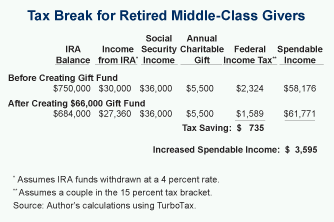Charitable gift funds are more than a toy of the nearly rich. They offer a surprising advantage to retirees with ordinary incomes. Using a charitable gift fund, a retired couple can increase their giving or increase the amount they spend on themselves. Or they can do a bit of both.
Follow me while I show you what can happen when a retired couple makes a charitable gift.
A Charitable Gift Can Raise Taxable Income. Suppose you are drawing Social Security benefits and covering additional expenses by making withdrawals from your Individual Retirement Account (IRA). At year-end you withdraw $1,000 for a charitable donation. What happens?
The charity gets your check for $1,000. That's a good thing.
But the withdrawal caused your taxable income to rise by $1,000, since taxes on regular IRAs are deferred until the funds are withdrawn. Unless other deductions total at least $10,700 — the standard deduction for a married couple filing jointly for 2007 — that $1,000 won't provide any tax benefit. Many middle-income retiree households don't have enough deductions to itemize.
So your tax bill will increase by your marginal tax rate. For many retirees, that is 15 percent, or $150.
A Charitable Gift Can Trigger the Social Security Benefits Tax. Increasing your income by $1,000 may also cause some of your Social Security benefits to be taxed. This doesn't start at lofty incomes.
For example, a couple with $36,000 in Social Security benefits can have only $14,000 of income from other sources before triggering Social Security benefit taxation. The next $1,000 of income will cause $500 of benefits to be added to taxable income. This will increase their income tax bill by $75, a total of $225. It can get worse:
- If this couple withdraws more than $26,000 from their IRA, each additional $1,000 withdrawal will trigger taxation of $850 in Social Security benefits.
- They will have to pay $150 on the additional $1,000 and $127.50 more on the $850 in Social Security benefits, a total of $277.50.

Thus, giving $1,000 to charity can cause the retired couple to pay an additional $225, or more, in taxes to the federal government.
A Charitable Gift Fund Can Lower Taxes. Consider a retired couple with $36,000 in Social Security benefits and additional income from IRAs. Like many retirees, this couple doesn't itemize deductions. Charitable giving adds to their taxable income and provides no tax benefit.
They can enjoy lower taxes and greater spendable income by making a one-time donation of $66,000 (or some other amount) to a charitable gift fund.
When the charitable gift fund is established, withdrawing the money from the IRA creates a taxable event. But the taxable income would be offset by an itemized deduction in the same amount, so there would be zero taxes (except for any benefit the couple would have gained by using the standard deduction over itemizing and possible taxes on some Social Security benefits).
Once the fund is established, their tax situation changes. The couple makes annual gifts from the fund, not from income. Suppose they make an annual gift of $5,500. Once they have made the gift, their nest egg will produce less income, lowering their income tax bill.
As a consequence, the retirees may fulfill their desire to donate $5,500 a year but have as much as $3,595 more to spend (or give) each year — because they created a charitable gift fund. [See the table.]
The retired couple, in other words, can donate $5,500 and spend an additional $3,595 a year on themselves. They can give both benefits, $9,095, to charity. Or they can do something in between.
Some readers may think withdrawing $5,500 from a $66,000 charitable gift fund is excessive; it reflects an 8.3 percent withdrawal rate. The choice is deliberate. Using Bill Sholar's www.FIRECalc.com, I found that a gift fund portfolio that is at least 66 percent equities has about a 60 percent chance of surviving for 15 years.
If you visit the life expectancy probability calculator on the Vanguard Web site, a 65-year-old man has about the same chance of living for 15 years — so the odds are about equal that a life (or death) event will cause charitable giving to be re-examined.
Firms Offer Charitable Gift Fund Management. Fidelity Investments started the first charitable gift fund (CGF) 16 years ago, allowing donors to give cash or securities, get an immediate tax deduction for the value of their donation and have the money managed by Fidelity. Fidelity charges a fee for operating the fund, as well as fees for managing the actual assets, but donors are saved the cost of establishing a personal foundation.
"Retired givers can receive a tax break for establishing a charitable gift fund."
The Fidelity CGF now boasts over $3.5 billion in assets contributed by 39,000 donors. Many financial services companies have established their own charitable gift funds. The next largest are Vanguard and Charles Schwab at $1.25 billion and $1.1 billion, respectively.
Once a donor account is established, donors can instruct the fund to issue checks to any qualified charitable organization. The minimum initial donations for the Fidelity, Vanguard and Schwab gift funds are $5,000, $25,000 and $10,000, respectively.
Conclusion. If seniors aren't careful about how they structure their donations, charitable giving can result in a higher tax bill. Whether you are a Republican or a Democrat, I think you'll agree that is not how it is supposed to work. That's the mess both parties have made of our tax system
Scott Burns is a financial columnist and coauthor of The Coming Generational Storm (Boston: MIT Press, 2004). Scott Burns © 2007. Reprinted by permission of Universal Press Syndicate. All rights reserved.